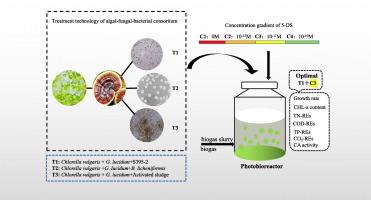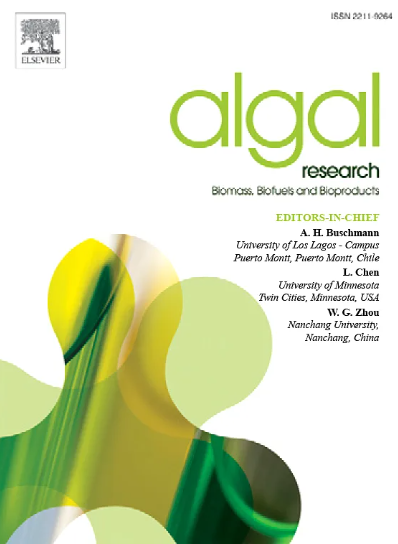进水 5-脱氧斯的明浓度对不同藻类-真菌-细菌联合体整体沼气升级和营养物质去除的影响
IF 4.6
2区 生物学
Q1 BIOTECHNOLOGY & APPLIED MICROBIOLOGY
Algal Research-Biomass Biofuels and Bioproducts
Pub Date : 2024-10-23
DOI:10.1016/j.algal.2024.103770
引用次数: 0
摘要
沼气质量不高、沼液处理困难是制约发酵工业发展的重要瓶颈。研究了5-脱氧斯的明(5DS)对不同藻类-真菌-细菌联合体的生长速率、日生产力和光合作用性能的影响,并考察了内生菌(S395-2)、灵芝(G. lucidum)、地衣芽孢杆菌(B. licheniformis)和活性污泥在这些系统中的辅助活性。结果发现,小球藻(C. vulgaris)+灵芝(G. lucidum)+S395-2 联合体是沼气升级和营养物质去除的最有效组合。在最佳 5DS 浓度为 10-11 M 时,化学需氧量 (COD)、总氮 (TN) 和总磷 (TP) 的去除率分别约为 82.94 ± 7.88 %、81.36 ± 7.79 % 和 83.27 ± 8.09 %,二氧化碳的去除率约为 69.89 ± 6.57 %。在不同的藻类-真菌-细菌联合体中,5DS 处理对生长性能和光合速率的影响是积极的。本研究为三相共生体的高效沼气升级和养分去除提供了一个框架。本文章由计算机程序翻译,如有差异,请以英文原文为准。

The effects of influent 5-Deoxystrigol concentrations on integral biogas upgrading and nutrient removal by different algal-fungal-bacterial consortium
The low quality of biogas and the difficulties in treating biogas slurry are important bottlenecks that limit the development of the fermentation industry. The effects of 5-deoxystrigol (5DS) on the growth rate, daily productivity, and photosynthetic performance of different algal-fungal-bacterial consortia were investigated, and the auxiliary activities of endophytic bacteria (S395–2), Ganoderma lucidum (G. lucidum), Bacillus licheniformis (B. licheniformis), and activated sludge in these systems were examined. The consortium Chlorella vulgaris (C. vulgaris) + G. lucidum + S395–2 was found to be the most effective combination for both biogas upgrading and nutrient removal. Removal efficiencies of chemical oxygen demand (COD), total nitrogen (TN), and total phosphorous (TP) were approximately 82.94 ± 7.88 %, 81.36 ± 7.79 %, and 83.27 ± 8.09 %, respectively, and the CO2 removal efficiency was observed to be about 69.89 ± 6.57 % at the optimum 5DS concentration of 10−11 M. On day 7 of the treatment, the CH4 content was elevated from 66.07 ± 4.84 % to 86.24 ± 8.44 %. The effect of 5DS treatments in different algal-fungal-bacterial consortia was positive in terms of growth performance and photosynthetic rate. The present study provides a framework for efficient biogas upgrading and nutrient removal by the three-phase symbionts.
求助全文
通过发布文献求助,成功后即可免费获取论文全文。
去求助
来源期刊

Algal Research-Biomass Biofuels and Bioproducts
BIOTECHNOLOGY & APPLIED MICROBIOLOGY-
CiteScore
9.40
自引率
7.80%
发文量
332
期刊介绍:
Algal Research is an international phycology journal covering all areas of emerging technologies in algae biology, biomass production, cultivation, harvesting, extraction, bioproducts, biorefinery, engineering, and econometrics. Algae is defined to include cyanobacteria, microalgae, and protists and symbionts of interest in biotechnology. The journal publishes original research and reviews for the following scope: algal biology, including but not exclusive to: phylogeny, biodiversity, molecular traits, metabolic regulation, and genetic engineering, algal cultivation, e.g. phototrophic systems, heterotrophic systems, and mixotrophic systems, algal harvesting and extraction systems, biotechnology to convert algal biomass and components into biofuels and bioproducts, e.g., nutraceuticals, pharmaceuticals, animal feed, plastics, etc. algal products and their economic assessment
 求助内容:
求助内容: 应助结果提醒方式:
应助结果提醒方式:


